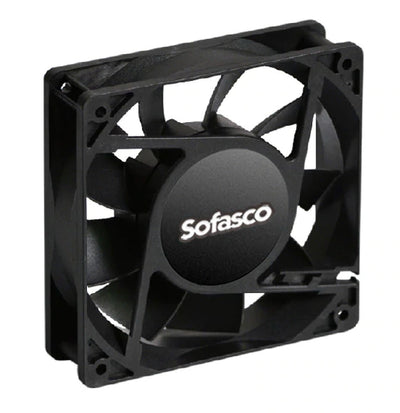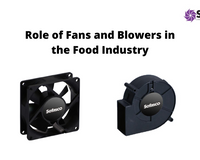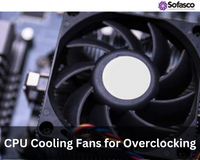In the realm of technology cooling fans play a crucial role in maintaining optimal operating conditions for various devices and machinery. Whether it's a computer processor, an industrial motor, or an HVAC system, cooling fans are the unsung heroes that keep temperatures in check and performance at its peak.
One fundamental aspect that distinguishes these fans is the type of bearings they employ – sleeve bearings and ball bearings. While both are designed to reduce friction and facilitate smooth rotation, they have distinct characteristics that make them suitable for specific applications. In this blog, we delve into the world of cooling fans, exploring the differences between sleeve bearings and ball bearings, and shedding light on how these differences impact fan performance, durability, and overall functionality.

Sofasco is a leading manufacturer of ball bearings for AC/DC axial fans, cross flow fans, centrifugal fans, and AC/DC blowers.

Sofasco is a leading manufacturer of sleeve bearings for axial fans, cross flow fans, centrifugal fans, and blowers.
Importance of Bearings in Cooling Fans
Cooling fans are pivotal components in various applications, entrusted with the critical task of managing heat dissipation and maintaining optimal temperatures. Bearings, in the context of cooling fans, play an indispensable role in ensuring efficient fan operation and overall system performance.
- Efficient Operation and Heat Dissipation: Bearings facilitate the smooth rotation of the fan blades, minimizing friction and enabling efficient airflow. As the fan blades spin, they draw air over heat-producing components, such as processors or radiators, enhancing heat dissipation. This efficient air movement prevents components from overheating and ensures that the system can operate at peak performance without thermal throttling.
- Impact on Fan Lifespan and Performance: The choice of bearings directly influences the lifespan and performance of cooling fans. Bearings that provide stable and frictionless rotation contribute to prolonged fan life, reducing the need for frequent replacements. Moreover, proper bearing selection enhances overall fan performance, maintaining consistent airflow and temperature regulation throughout the fan's operational life.
Types of Bearings Used in Cooling Fans
Cooling fans utilize two primary types of bearings: sleeve bearings and ball bearings. Each type offers distinct advantages and limitations, influencing factors such as noise level, durability, and suitability for specific applications.
- Sleeve Bearings: Sleeve bearings, also known as plain bearings, employ a simple yet effective mechanism. A cylindrical sleeve separates the rotating shaft from the stationary portion of the bearing, reducing friction and enabling smooth rotation. Sleeve bearings are characterized by their quiet operation, cost-effectiveness, and suitability for horizontal mounting orientations.
- Ball Bearings: Ball bearings introduce small metal balls between the moving parts, providing enhanced durability and reduced friction. This design allows for smoother and more efficient rotation, making ball bearings well-suited for high-performance applications and vertical installations.
Sleeve Bearings
Sleeve bearings operate on the principle of a rotating shaft supported by a lubricated sleeve. The sleeve reduces friction between the shaft and the bearing housing, allowing for relatively smooth rotation. A simple diagram can help illustrate this mechanism:
Advantages of Sleeve Bearings
- Quiet Operation: Sleeve bearings are prized for their silent performance, making them an excellent choice for environments where noise is a concern, such as home appliances or office settings.
- Cost-Effectiveness: Sleeve bearings are economical to manufacture and maintain, offering a budget-friendly option for cooling fan applications.
- Suitable for Horizontal Mounting: Sleeve bearings are well-suited for horizontal fan mounting, as they can effectively support the weight of the rotating components in this orientation.
Limitations of Sleeve Bearings
- Lifespan and Durability Concerns: Sleeve bearings have a finite lifespan and are more prone to wear over time, which can lead to reduced fan performance and eventual failure if not properly maintained.
- Unsuitability for High-Performance or Vertical Applications: Sleeve bearings may struggle to handle the demands of high-performance systems or vertical installations due to their limited durability and potential lubrication issues.
Ball Bearings
Ball bearings utilize small metal balls to reduce friction and enable smooth rotation. This mechanism involves the interaction of rolling elements within the bearing housing. Here's a simplified explanation:
Advantages of Ball Bearings
- Longer Lifespan and Durability: Ball bearings outshine sleeve bearings in terms of longevity and durability, making them a preferred choice for applications that require extended operational life.
- Suitable for High-Performance and Vertical Installations: Ball bearings excel in high-performance environments and vertical mounting orientations, where they can efficiently handle increased loads and forces.
- Reduced Friction and Improved Efficiency: The rolling action of ball bearings significantly reduces friction, resulting in improved efficiency and potentially lower energy consumption.
Limitations of Ball Bearings
- Noisier Operation Compared to Sleeve Bearings: Ball bearings can produce more audible noise during operation compared to the quieter performance of sleeve bearings.
- Higher Cost: The enhanced performance and durability of ball bearings come at a higher cost, which may impact budget-conscious projects.
Choosing the Right Bearing for Your Cooling Fan
Selecting the appropriate bearing type for your cooling fan is a pivotal decision that can significantly impact the fan's performance, longevity, and overall efficiency. To make an informed choice, it's crucial to consider a range of factors that align with your specific requirements. This section outlines the key considerations and the decision-making process to guide you in selecting the optimal bearing type.
- Assess Application Requirements: Before choosing a bearing for your cooling fan, carefully analyze the specific needs of your application. Consider the level of cooling performance required, whether it's for a standard application or a high-performance system. Understanding these application requirements will help guide your bearing selection process, ensuring that the chosen bearing type aligns perfectly with the cooling demands and intended usage.
- Budget Constraints: Evaluate your budget constraints and allocate resources accordingly. While ball bearings offer enhanced durability, they often come at a higher cost compared to the more budget-friendly sleeve bearings. Assess whether the benefits of ball bearings align with your budget allowances and long-term goals.
- Noise Tolerance: Consider the noise level acceptable for your application. Sleeve bearings are renowned for their quiet operation, making them ideal for environments where noise is a concern, such as home electronics or office equipment. On the other hand, ball bearings may produce more noise during operation.
- Match Bearing Type with Cooling Fan Purpose: Align the bearing type with the specific purpose of your cooling fan. If you're aiming for a quiet and cost-effective solution with horizontal mounting, sleeve bearings may be the right fit. Alternatively, if your application demands high-performance cooling, vertical mounting, or extended durability, ball bearings could be the optimal choice. The bearing type you select should seamlessly integrate with your cooling fan's intended use and performance objectives.
- Weigh Pros and Cons: Thoroughly evaluate the pros and cons of each bearing type based on your project's requirements. Consider the advantages, such as quiet operation and cost-effectiveness with sleeve bearings, versus the potential drawbacks like limited lifespan. Similarly, weigh the extended durability and efficiency benefits of ball bearings against factors like noise and higher cost. A clear understanding of the trade-offs will aid in making an informed decision.
By carefully considering these factors and integrating it into your cooling fan system. Regularly monitor the fan's performance, including its ability to regulate temperatures and manage heat dissipation. Keeping a watchful eye on these aspects will help ensure that your chosen bearing type is effectively meeting the cooling demands of your application over time.
Sofasco specializes in designing and manufacturing industrial cooling fans with ball and sleeve bearing technology in varied specifications such as axial fans, cross-flow fans, blowers, dustproof cooling fans, and telecom fans. With years of market presence and a team of skilled employees, the company is dedicated to providing high-quality cooling solutions for various industries. Get in touch with their team to know more about these industrial fans.












